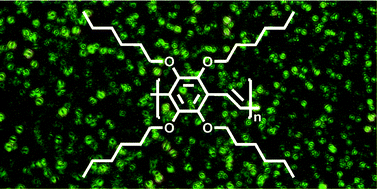Tetra-alkoxy substituted PPV derivatives: a new class of highly soluble liquid crystalline conjugated polymers†
Abstract
Two first examples of highly soluble tetra-alkoxy substituted PPV derivatives, poly(2,3,5,6-tetrahexyloxy-1,4-phenylene

* Corresponding authors
a
Hasselt University, Institute for Materials Research (IMO), Agoralaan, Building D, Diepenbeek, Belgium
E-mail:
thomas.cleij@uhasselt.be
Fax: +32-11-268301
Tel: +32-11-268310
b IMEC, Division IMOMEC, Wetenschapspark 1, Diepenbeek, Belgium
c Instituto de Ciencia Molecular (ICMol), Universidad de Valencia, P.O. Box 22085, Valencia, Spain
Two first examples of highly soluble tetra-alkoxy substituted PPV derivatives, poly(2,3,5,6-tetrahexyloxy-1,4-phenylene

 Please wait while we load your content...
Something went wrong. Try again?
Please wait while we load your content...
Something went wrong. Try again?
J. Vandenbergh, I. Van Severen, L. Lutsen, P. Adriaensens, H. J. Bolink, T. J. Cleij and D. Vanderzande, Polym. Chem., 2011, 2, 1279 DOI: 10.1039/C1PY00027F
To request permission to reproduce material from this article, please go to the Copyright Clearance Center request page.
If you are an author contributing to an RSC publication, you do not need to request permission provided correct acknowledgement is given.
If you are the author of this article, you do not need to request permission to reproduce figures and diagrams provided correct acknowledgement is given. If you want to reproduce the whole article in a third-party publication (excluding your thesis/dissertation for which permission is not required) please go to the Copyright Clearance Center request page.
Read more about how to correctly acknowledge RSC content.
 Fetching data from CrossRef.
Fetching data from CrossRef.
This may take some time to load.
Loading related content
